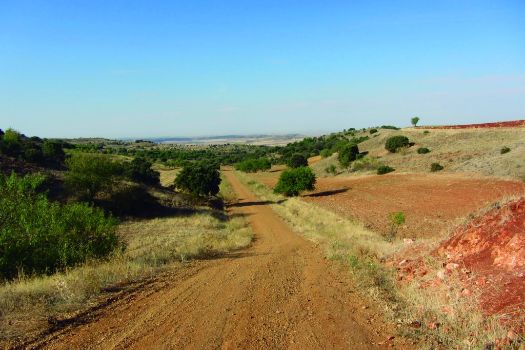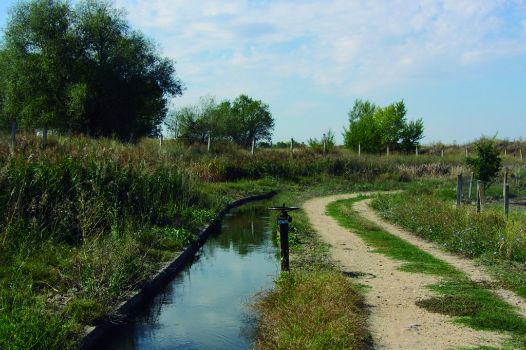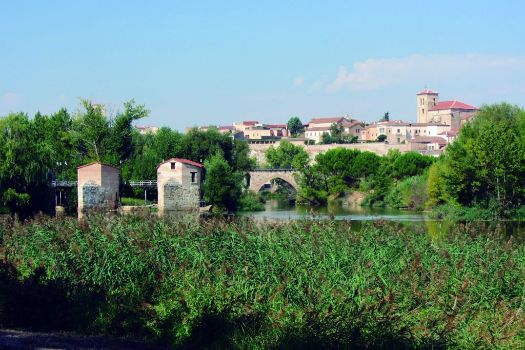Net of Natural
Trails

Stage 18: Toro - Zamora
Description
"Tablas" of the Duero
The Nature Trail reaches Zamora, where the river flows through flatter terrain, forming backwaters known as "tablas”. The river widens and the current flows slower. The riparian vegetation is dense and diverse, providing a pleasant walk in the shade.
The Stage begins on the outskirts of the town of Toro, next to the CL-519. The trail runs north until it reaches the CL-602, which it crosses, and continues through a vast cornfield with many small sheds.

The river always runs close to the path, hidden behind a dense riparian forest; hence, its waters will rarely be visible. The Trail continues along San José Canal on a wide forest track flanked by crop farms and small market gardens.
The Trail escorts the River Duero, which appears almost at a standstill. This Stages host many more fish species than the upper reaches, including Northern straight-mouth nase (Chondrostoma duriense), common Iberian barbel (Barbus bocagei), Iberian roach (Chondrostoma arcasii) and red swamp crayfish (Procambarus clarkii) that feed on small invertebrates and underwater plants. This, coupled with lush and diverse vegetation, has created a habitat with a wide variety of wildlife, including otters (Lutra lutra), Grey Herons (Ardea cinerea), Common Kingfishers (Alcedo atthis), Little Grebes (Tachybaptus ruficollis), grass snakes (Natrix natrix), Southwestern water vole (Arvicola sapidus), Eurasian Reed Warblers (Acrocephalus scirpaceus), Little Ringed Plovers (Charadrius dubius), Eurasian Gold Orioles (Oriolus oriolus), Common Chiffchaff (Phylloscopus collybita), Eurasian Sparrowhawks (Accipiter nisus) and Common Kestrels (Falco tinnunculus).
The path passes under the AVE railway, and continues until a sign indicating that the route turns left onto Camino de San Miguel towards the town of Peleagonzalo. It was in these fields where, in 1476, the battle that ended the Spanish civil war between the victorious Isabella the Catholic and Juana la Beltraneja was fought.
After traversing the village along its eastern edge, the path climbs up a small valley, amidst oaks and rockrose, with the Peleagonzalo wineries to the right.

At a signposted junction, the route takes the track on the right that leads to a fire lookout tower with nice views of the whole county.
After traversing a few hundred meters through a young stone pinewood (Pinus pinea), the path climbs down to an area under cereal crops.
The Trail ventures through the bottom of a valley, with rocky cliffs and small hills to the right, where wind turbines have been installed.
The Nature Trail crosses the valley and climbs up a hill, then down to the town of Madridanos. The path crosses the town along its north edge. The landscape is now dominated by irrigated fields of crops.

The route heads to Villaralbo, which it traverses, from east to west, along General Mola and Ochavo streets. At the edge of the town, the path turns left and continues parallel to San José Canal, which runs west, until it arrives at an area dotted by small businesses, houses and farms.
The Trail passes under the A-66 (Ruta de la Plata), another historic milestone. It now turns right, and then left to pass under the A-11 (Zamora's ring road). From here, the landscape is distinctly urban.
The path heads along the river and passes under an abandoned railroad, leaving the Puente de Hierro, Zamora´s southern access point, to the right. The river has several small dams or weirs that slow the current. In bygone days, it was used to guide the water towards the "Aceñas" on both sides of the canal: Olivares at the foot of the castle, and Cabañales and Pinilla next to the Puente de Piedra and Puente de Hierro.
The Stage ends at a riverside park with fountains where one can refresh oneself and enjoy a leisurely stroll through the city.
Sites of interest
Profile

Highlights
Further information
Market gardens
Between stone and adobe walls, market gardens flourish in this wet, cool environment. Leeks, onions, cabbages, beans, lettuces, potatoes, pumpkins, squash and many other vegetables grow in perfectly aligned rows in small and not so small gardens.
Market gardens lost their original value over the centuries, as they were no longer viewed as essential to the family economy, and became little more than a playground for gardening enthusiasts. There are also orchards interspersed between the rows of market gardens.
Wildlife in wheat fields
While it may appear that nothing other than plants can live in the fields of wheat and barley, nothing could be further from the truth. Hundreds of small invertebrates are at the mercy of Northern Lapwings (Vanellus vanellus), Wagtails (Motacilla alba), European Starlings (Sturnus vulgaris), Eurasian Jackdaws (Corvus monedula) and European White Storks (Ciconia ciconia) when the fields are ploughed and sown.
The mineral fertiliser pellets used to fertilise the land attract pigeons and partridges, who mistake the pellets for seeds.
The stones removed from the land are stacked into "majanos" where rabbits (Oryctolagus cuniculus), foxes (Vulpes vulpes), least weasels (Mustela nivalis) and Little Owls (Athene noctua) build their nests.
Different species thrive on the boundary lines and slopes, producing seeds and fostering the growth of insects. These resources are used by Northern Wheatears (Oenanthe oenanthe), Meadow Pipits (Anthus pratensis), Eurasian Skylarks (Alauda arvensis) and small rodents, which in turn attract larger predators such as Northern Harriers (Circus cyaneus) and Eurasian Hobbies (Falco subbuteo).





